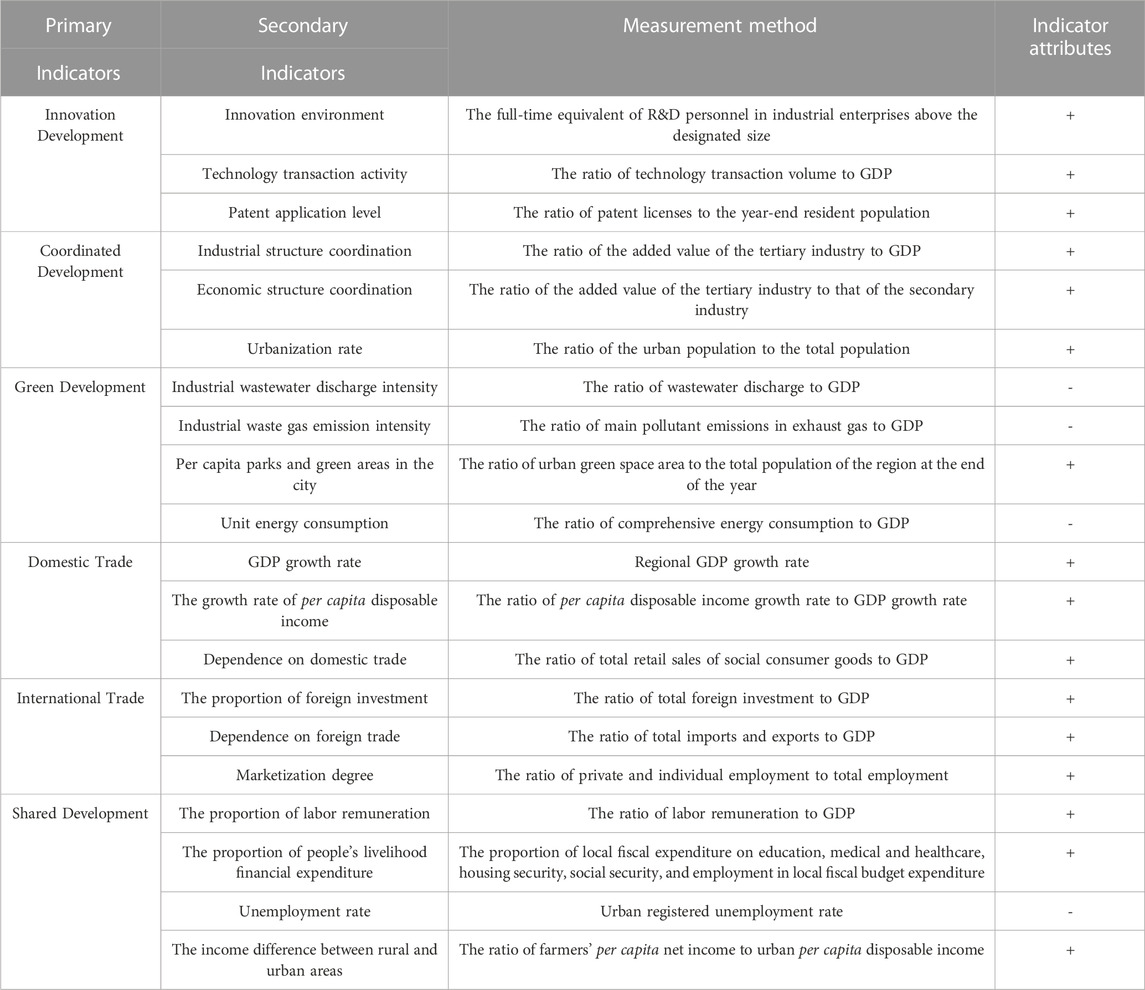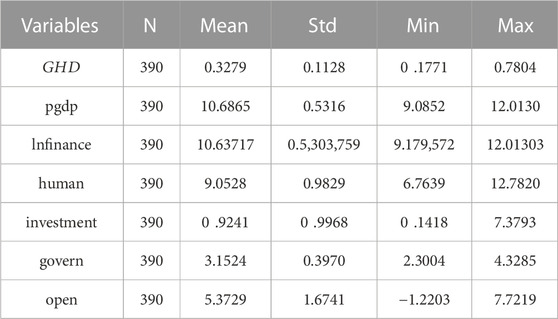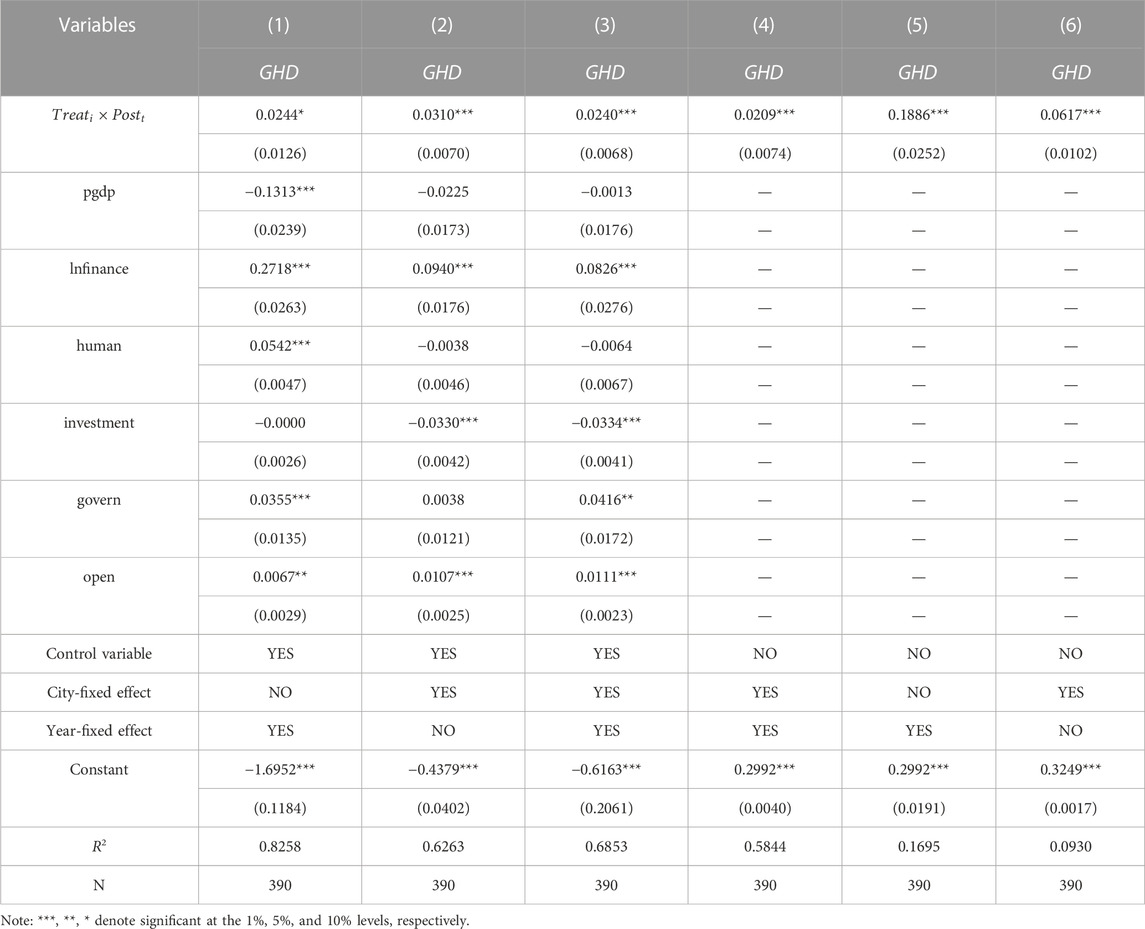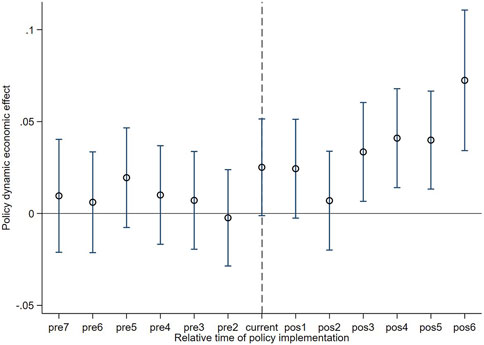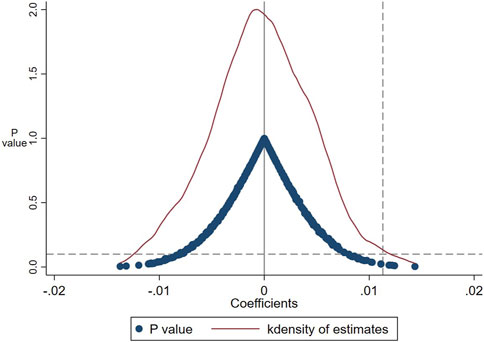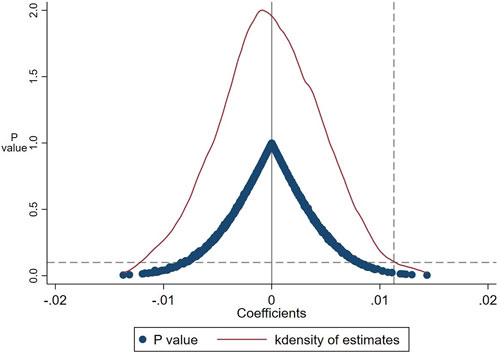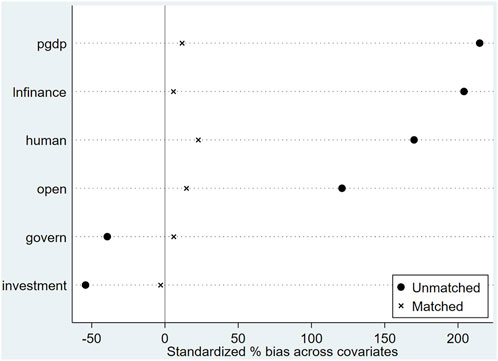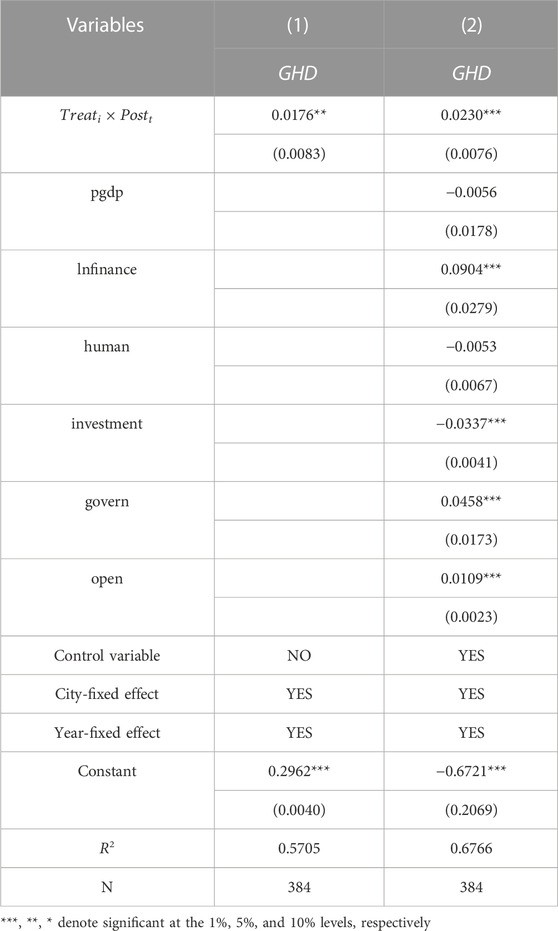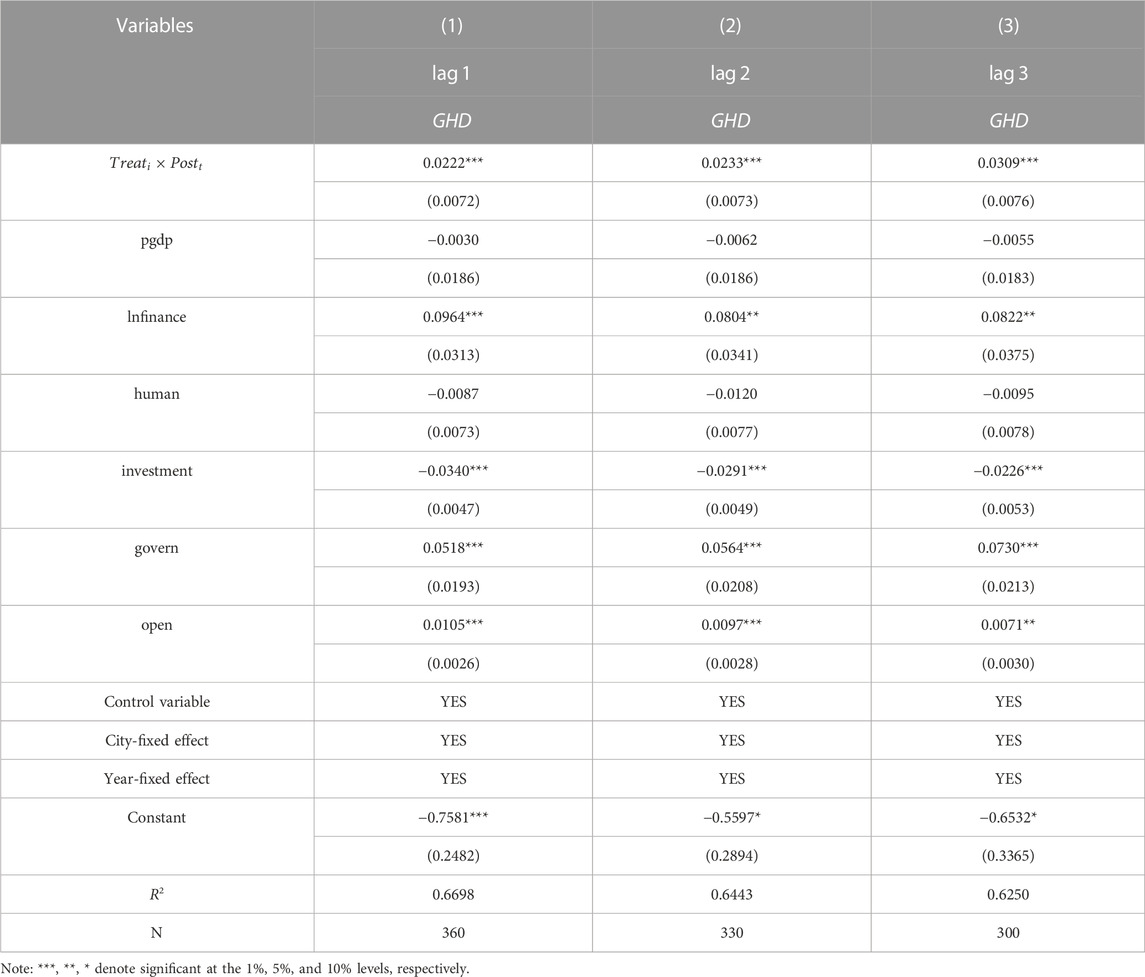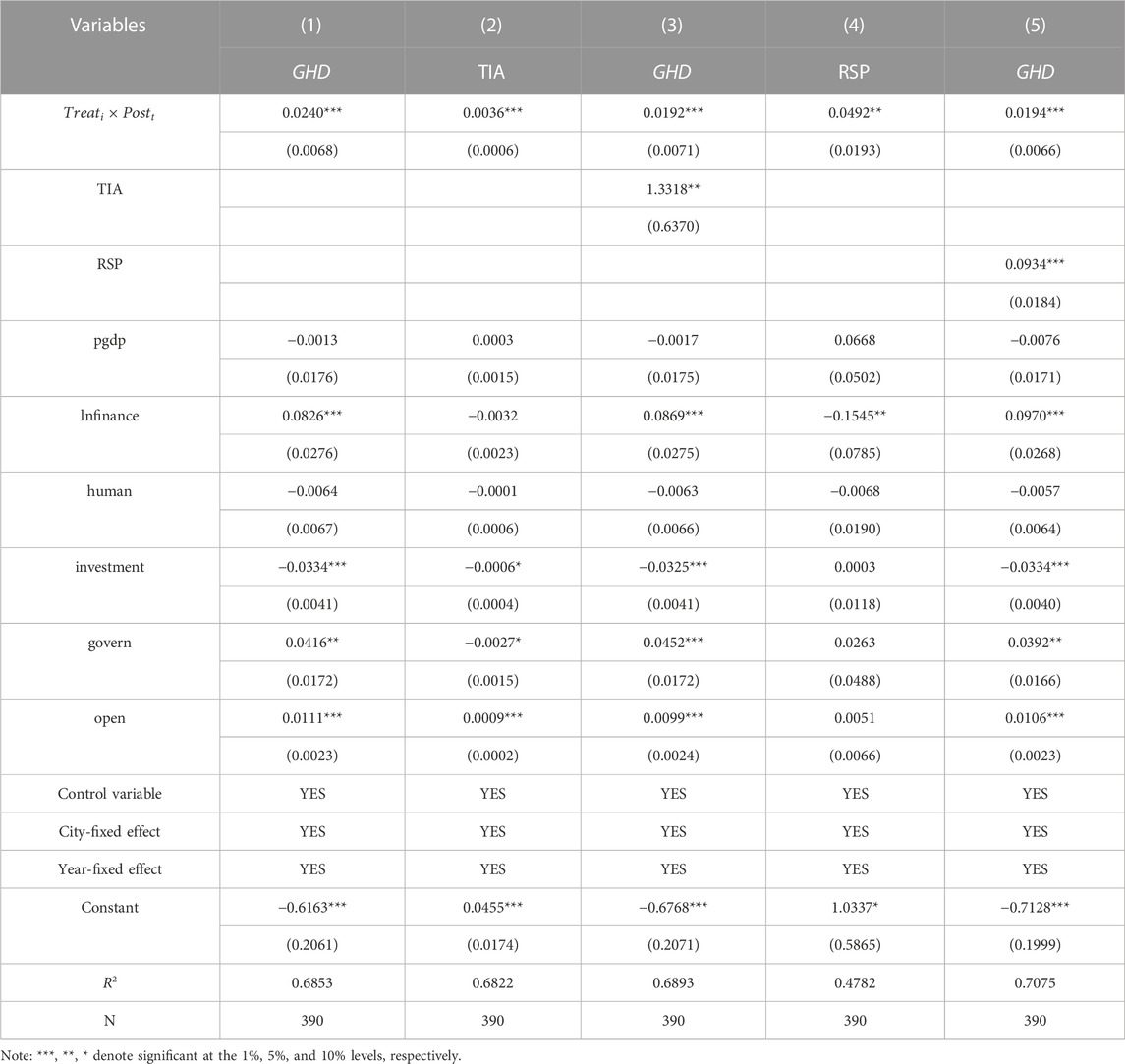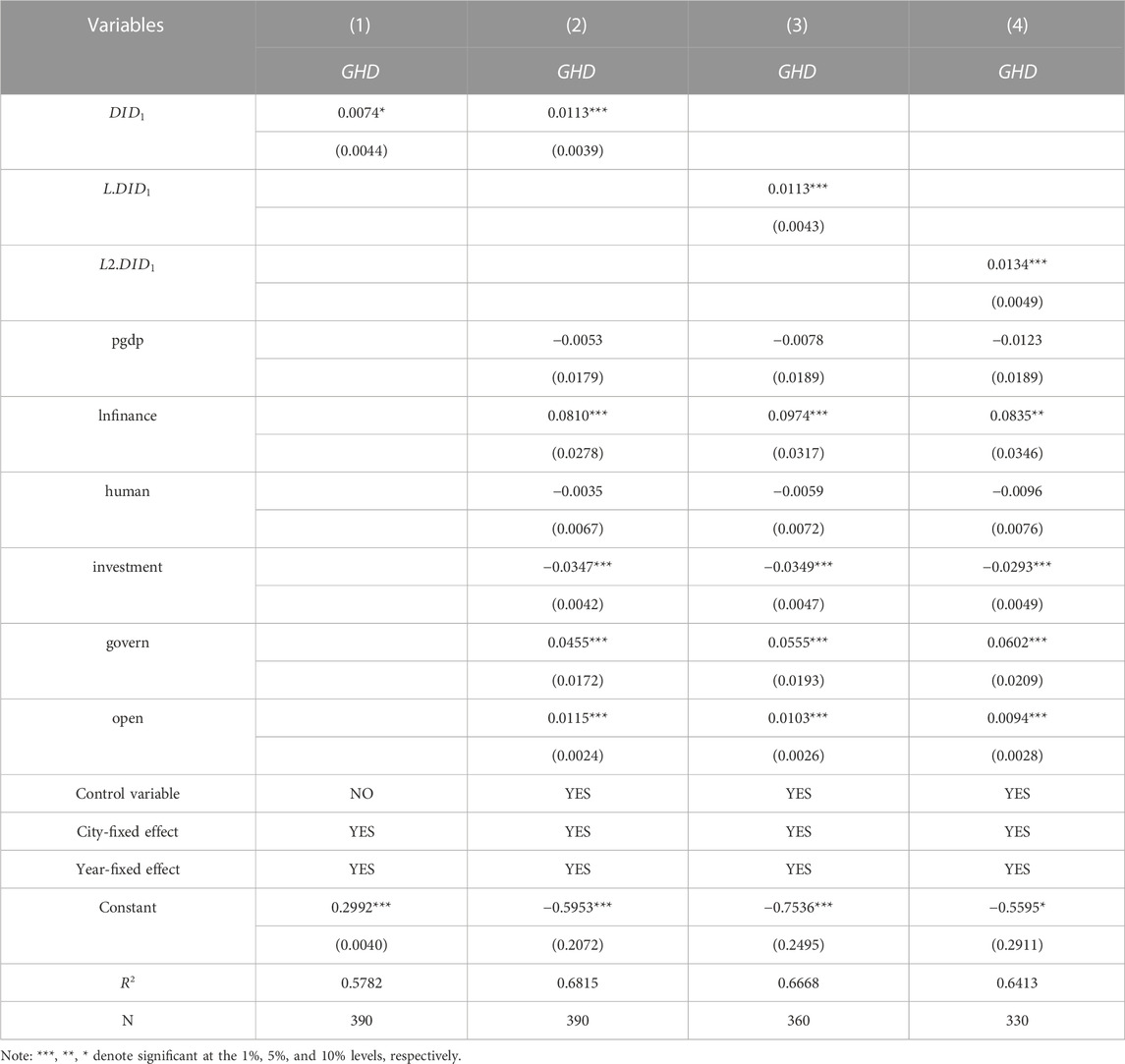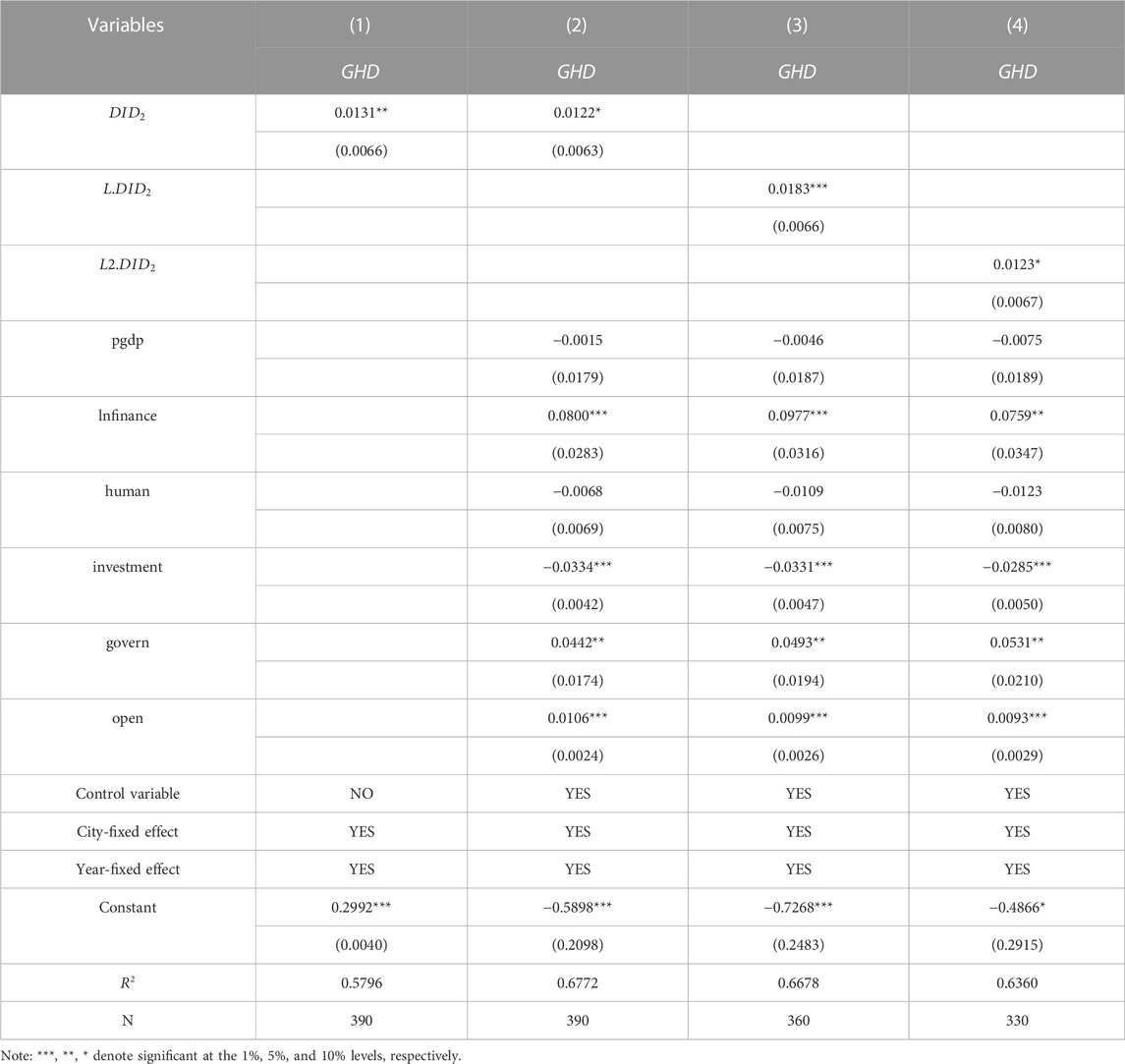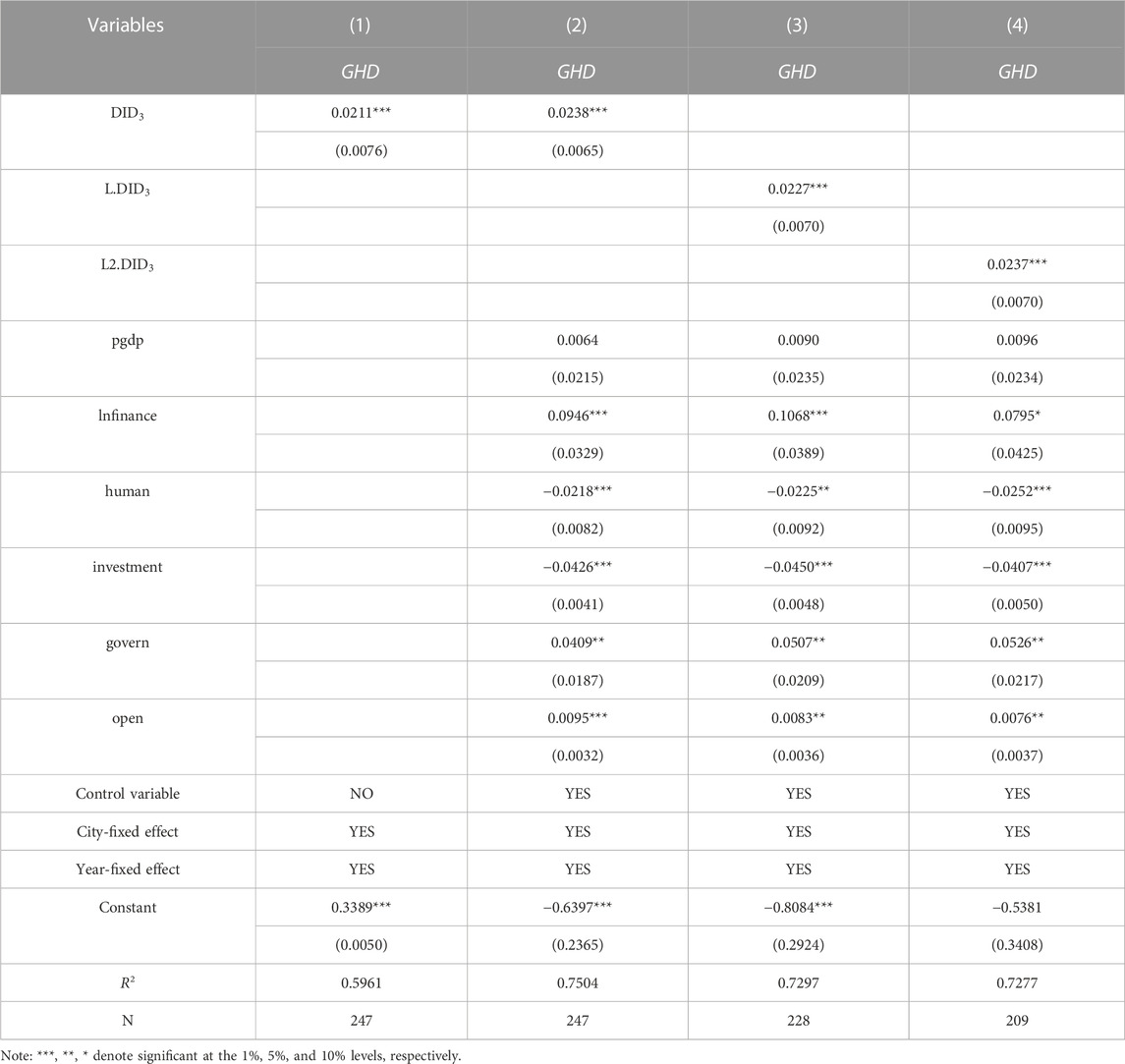- School of Economics and Management, Shanghai Institute of Technology, Shanghai, China
Enhancing the green and high-quality development of urban in China and exploring the synergistic effects of multiple policy implementations is the key to effectively playing the leading role of policies. To explore the synergistic effects and driving mechanisms of dual policies on regional green development, this study selected panel data from 30 provinces in China from 2008 to 2020. Employing Multi-period difference-in-differences and Mediation effects models, the research systematically explores the synergistic effects of these dual-pilot policies on urban green and high-quality development. The findings of this study reveal a significant improvement in the level of urban green development under the influence of the dual-pilot policy. After conducting a series of rigorous tests for robustness, this conclusion remains valid. This improvement is primarily attributed to the stimulation of technological innovation capabilities and the optimization of industrial structures within the cities. Compared to the carbon emissions trading city single pilot and free trade zone city single pilot, the dual pilot effect of carbon emissions trading and free trade zone city is stronger. The carbon emissions trading city pilot and free trade zone city pilot have a synergistic effect on regional green and high-quality development. This research provides valuable theoretical insights to guide the planning of pilot cities, facilitating the realization of both high-quality economic development and sustainability objectives.
1 Introduction
Reducing the negative impact of environmental pollution on economic growth is crucial for promoting sustainable urban development. Opting for an eco-friendly path is an unavoidable decision for economic growth, societal wellbeing, and the health of our surroundings (Shen et al., 2023). This approach aligns with the core principles of many international policies established in recent times (Ramzan et al., 2023). In the wake of economic reforms and increased openness, the outdated model of resource-intensive development has resulted in significant challenges related to environmental contamination. The path of green development serves as both the impetus for China’s progression toward an ecologically civilized society and a pivotal lever for reshaping the economic growth model (Xu et al., 2022). China explicitly outlined the objective of fostering widespread green production and lifestyle by 2035, facilitating a fundamental improvement in the ecological environment and substantially realizing the goal of building a beautiful China. In November 2022, in response to global climate change, China proposed, “It must be propelled by scientific and technological advancements, facilitating the transition and enhancement of energy resources, industrial composition, and consumption patterns, ultimately fostering the advancement of both green economics and societal progress”. Exploring new pathways that harmonize development and protection. The green transformation of the economy is an inevitable choice for resolving the ecological challenges within China’s pursuit of high-quality economic development. Supporting high-quality development with high-level ecological and environmental protection and making green the most distinctive foundation of high-quality development is the ultimate goal of China’s green development.
After years of economic reform and development, China’s economy has ascended to the world’s second-largest. However, environmental pollution and deteriorating ecological conditions have become prevalent because of its economic development mode and stage constraints. China’s economy has entered a phase of high-quality development, making achieving high-quality economic growth a focal point for government departments at all levels. Confronted with escalating environmental pressures, China has been actively promoting pilot projects encouraging regions to implement carbon emissions reductions. To curtail environmental pollution, foster regional carbon emissions reductions, stimulate low-carbon economic growth and achieve Green High-quality Development (GHD), the National Development and Reform Commission introduced the “Notice on Launching Pilot Work for Carbon Emissions Trading” in November 2011. This policy specified that Beijing and seven other provinces and cities would serve as pilot areas for carbon emissions trading, with gradual implementation commencing at the end of 2013. The establishment of the carbon emissions trading market represents a noteworthy innovation within China’s institutional framework aimed at tackling climate change and environmental pollution and fostering high-quality economic development through market-oriented mechanisms. The implementation of this policy has the potential to stimulate technological innovation among businesses while simultaneously mitigating environmental pollution and greenhouse gas emissions, facilitating the transformation and upgrading of industrial structures. Furthermore, it can accelerate the transition of regional economic development models, transitioning from reliance on factors to embracing innovation as a driver, ultimately leading to the achievement of high-quality regional economic growth.
Furthermore, within the context of the relevant green development policies, researchers have also determined that the pilot initiatives within free trade zone municipalities exert a more pronounced influence on the promotion of sustainable urban development and the management of environmental pollution. Under the economic situation of increasing economic pressure, blocked export of enterprises and increasingly serious anti-globalization tendency, there are certain contradictions between expanding import and export trade, accelerating economic development and environmental protection. Current policies should aim to achieve an equilibrium between fostering trade expansion, promoting economic growth, and preserving the environment. The pilot policies of free trade zones represent a significant decision for China to deepen reforms further, enhance trade openness, and promote economic growth. To strengthen the ecological and environmental protection efforts within free trade zones, in May 2021, the Ministry of Ecology and Environment and eight other departments jointly formulated the “Guiding Opinions on Strengthening Ecological Environment Protection in Free Trade Pilot Zones to Promote High-quality Development.” This document explicitly outlines measures to establish low-carbon pilot zones, construct ecological and environmental security zones, and set up model areas for international environmental cooperation. Therefore, within the context of adhering to a strategy of mutual benefit and win-win cooperation, as well as China’s goal of achieving high-quality development, the impact and effects of the free trade zone pilot policies on regional GHD hold significant practical significance.
Both the free trade zone pilot and carbon emission trading pilot can effectively support the enhancement of regional green development, constituting integral components of China’s ecological and environmental market construction. However, achieving a deeper integration of mechanisms, policies, and standards between the two to realize synergistic benefits in pollution reduction, carbon mitigation, and efficiency enhancement requires a further deepening institutional design. Considering the potential synergistic effects of combining these two policies and whether it can lead to more significant benefits from a policy coordination perspective, it is likely to open up new avenues for advancing regional high-quality development. Hence, this study aims to address the following questions: Does the combined use of the free trade zone policy and carbon emission trading policy have a better synergistic effect on regional green development? What are the specific mechanisms behind this effect? Are there differences in the effects of implementing a single policy versus implementing both policies in coordination? Which situation is more conducive to promoting cities’ GHD? Exploring these questions will effectively assist policymakers in enhancing regional green development and high-quality growth.
Given this, the potential incremental contributions of this paper can be outlined as follows: In terms of research perspective, this paper studies the synergistic effect of carbon emission trading city pilot policies and free trade zone city pilot policies on regional GHD. Although a few kinds of literature have studied the effects of the construction of free trade zone pilot cities and the construction of carbon emission trading markets on regional green development, this paper further considers whether there may be synergies between the two policies. This approach is a beneficial attempt to respond to the country’s “exploring a new path of synergy between development and protection,” it also reasonably supplements the existing research results. From the research methods, this paper considers the implementation time of the dual-pilot policies and the differences in the implementation cities. It adopts the multi-period difference-in-differences method to obtain the net effect of the impact of the establishment of the dual-pilot cities on regional GHD, avoiding the measurement error caused by endogenous problems. From the selection of indicators, this paper reflects the level of GHD by constructing an evaluation index system for regional GHD. In terms of index selection, follow the connotation of high-quality development proposed by China and select evaluation indicators that align with China’s national conditions from the five aspects of “innovation, coordination, green, openness, and sharing.” In contrast to the conventional approach of employing the SBM model to assess urban green total factor productivity through input and output considerations, this study places a heightened focus on the fresh paradigms and demands associated with China’s high-quality economic development in the contemporary era. From the research significance, this paper can provide a reference for improving the regional green development mode by analyzing the synergy of multi-policy implementation effects. Meanwhile, it brings enlightenment to implementing future environmental policies by considering the synergy between policies.
The subsequent organization of this paper is outlined below. In Chapter 2, an in-depth examination of existing literature is presented. Chapter 3 outlines the theoretical analysis and research hypotheses. The introduction of the pertinent model formulation and research hypotheses can be found in Chapter 4. Moving on to Chapter 5, an exposition of the empirical findings and analytical discussion is provided. Chapter 6 then conducts a more profound investigation into the article’s subject matter. Finally, Chapter 7 offers conclusive insights and policy suggestions.
2 Literature review
This study primarily focuses on research related to urban GHD and evaluating the impact of relevant pilot policies. Recent literature closely related to these topics has been categorized into three main sections for review.
2.1.1 Measurement of green high-quality development
Green High-quality Development is China’s new development stage and strategic goal. Taking the five development concepts of “innovation, coordination, green, openness and sharing” as the guiding ideology, it is also a process of continuously improving total factor productivity (TFP). Due to its rich connotation, a unified evaluation index system has not yet been formed. Early scholars adopted the traditional total factor productivity method to measure the level of high-quality development (Liu et al., 2021). However, this process does not take into account factors such as resource investment and the environment and cannot fit in with the new development concept of green development. The method of green total factor productivity was then derived to incorporate energy consumption and environmental pollution issues into the total factor productivity accounting system. It aims to measure the balance between economic growth and environmentally sustainable development to reflect the green and high quality of a country or region. At the same time, in order to conduct an in-depth analysis of GHD, when measuring green development, it is decomposed into green technical efficiency and green technical progress for in-depth discussion (Wang et al., 2021; Cheng and Jin, 2022). It provides a more in-depth discussion of the factors affecting green development. However, GHD covers all aspects of the economy and society. In addition to focusing on “quantitative” growth, it also pays more attention to “quality” improvement, which needs to be evaluated from many aspects.
In recent years, scholars have delved deeper into the study of GHD. Some argue that innovation, factor supply, organizational systems, policy environment, and governance level are essential drivers of GHD (Yang et al., 2022; Song et al., 2022). Others propose that a single metric is insufficient for measuring GHD, advocating for constructing indicator systems based on multiple dimensions such as innovation, coordination, green development, openness, and sharing (Zheng and He, 2022; Li and Liu, 2023; Li et al., 2023) pointed out that the fusion of economic growth and green development as the fundamental essence of the contemporary economic system. Building upon the essence of China’s novel development concept, they devised a gauge of the Chinese economy’s high-quality developmental stage. Subsequently, they employed the principal component analysis method to quantify the extent of China’s high economic high-quality development. Li and Wang (Li and Wang, 2023) redefine the connotation of GHD from the inside and outside of the city and provide a new perspective on the definition of GHD. Incorporate manufacturing-related indicators into the GHD evaluation index system to make it more comprehensive and compensate for existing research’s shortcomings. Although scholars have different definitions of GHD, the connotations of various definitions are relatively consistent, indicating that GHD is a relatively comprehensive concept. Compared with the earlier method of using input-output indicators to measure regional GHD, constructing an indicator system for measurement can better reflect the development needs of different regions at a specific stage.
2.1.2 Effectiveness of free trade zone policy
The pilot free trade zone is a test field for exploring a new round of system reform and innovation after China’s economic system reform enters the deep-water area. Since the China (Shanghai) Free Trade Zone was officially listed in September 2013, after several rounds of expansion, China has formed a new pattern of high-level regional opening up. In institutional innovation, each pilot trade zone insists on bold experimentation, bold breakthrough, and independent reform. Extensive efforts have been devoted to the realms of investment and trade liberalization, the facilitation of financial services to the real economy, and the transformation of government functions, resulting in notable accomplishments. It has explored an open model with institutional innovation as the core and has become a benchmark and model of openness in the new era. Promoted an important change in the concept of government management and became a pioneer in system innovation. Actively benchmark international high-standard investment and trade rules and become a linker and practitioner of international advanced rules (Chen et al., 2018). However, the original intention of establishing the free trade zone is not only institutional innovation but also to enhance the advancement of China’s economy through comprehensive reform trials and institutional innovation aimed at fostering high-quality development. The central development concept within China’s Pilot Free Trade Zone is “green development.” It aligns with the principle highlighted in the “Guiding Opinions on Reinforcing Ecological and Environmental Preservation in Pilot Free Trade Zones” released by China’s Ministry of Ecology and Environment, indicating that the concept of green development should permeate every facet of constructing pilot free trade zones. The Pilot Free Trade Zone will cultivate a contemporary environmentally-friendly service sector, promote sustainable manufacturing, build an eco-aware supply chain, and foster future-oriented green trade practices.
During the early stages of the reform and opening-up era, scholars predominantly focused on researching the regional economic growth resulting from the free trade zone policy. The researchers have discovered that free trade zones play a pivotal role in invigorating innovation and bolstering businesses’ competitive edge. The free trade zone policy has promoted regional economic growth by promoting foreign direct investment, upgrading industrial structure, and technological innovation (Aloise and Macke, 2017; Zhuo et al., 2021). Following the introduction of the green development concept, the functional orientation of the free trade zone policy extends beyond mere economic growth, placing greater emphasis on the harmonious progress of both economic advancement and environmental preservation. In recent years, exploring the impact of free trade zone policies on high-quality regional development has gradually become an emerging research field, competing to become a hot spot in the academic circle. Relevant foreign scholars have also explored the influence of free trade zone policies on green development from different perspectives. Wang et al. (Wang et al., 2022) used the data from China’s provinces to find that the free trade zone policy can promote regional GHD. The main way is to promote the rational development of regional industrial structure and improve innovation ability. Jiang et al. (Jiang et al., 2021) used the input-output method based on the micro-data of enterprises. They used the green total factor productivity to measure the quality of economic development to study the net effect of establishing the Shanghai Pilot Free Trade Zone on the green total factor productivity of municipal enterprises in Shanghai. The findings indicate that owing to technological advancements, the free trade zone in Shanghai has contributed to the enhancement of the overall green productivity of local businesses. Bi et al. (Bi et al., 2023) observed, through data analysis conducted at the prefecture-level city level in China, that free trade zones, functioning as “green zones” for executing planning initiatives and institutional reforms, contribute positively to the advancement of environmentally friendly and sustainable urban development. They also find that free trade zones are the main channel for enhancing regional green development by fostering foreign direct investment and facilitating upgrades in industrial structure, thereby establishing a connection between free trade zones and enhancing green total factor productivity.
2.1.3 Effectiveness of carbon emission trading pilot policy
To promote regional GHD, curbing severe carbon emissions is necessary to mitigate their negative effects and address environmental pollution at the source (Chen et al., 2020). Since introducing the EU’s carbon trading market, market-based mechanisms featuring carbon quotas and prices have proven effective in reducing emissions by restricting corporate carbon emissions and incentivizing carbon mitigation efforts. This approach has been imitated by more and more countries (Ding et al., 2019). Taking a cue from the European Union’s experience, China initiated pilot carbon emissions trading policies in 2011, with subsequent launches taking place at the close of 2013 and beyond. Studies have shifted toward understanding the policy’s impact on the economic system. The policy has so far involved seven provinces in China. The implementation of this policy has made scholars’ research gradually turn to the impact of this policy on the entire economic system. Several studies have shown that carbon trading pilots reduce energy consumption and enable corporate innovation (Zhang et al., 2019; Zhang et al., 2022; Shi et al., 2022). Fu et al. (Fu et al., 2023) found that carbon emissions trading is important to promote GHD. As a quota-based market-driven environmental regulatory policy, the carbon emission trading policy induces enterprises to carry out green innovation behaviors by transforming enterprises’ environmental responsibilities into conscious behaviors. It will lead to a significant increase in the quantity and quality of green technological innovations of enterprises, which will affect the development of green innovation in the region. Xiao et al. (Xiao et al., 2021) found that in addressing climate change and promoting high-quality development, carbon emission trading policies significantly increased total factor productivity at the firm level. This has brought new opportunities for comprehensively promoting the high-quality development of enterprises. Another example is that Chang and Wang (Chang and Wang, 2023) conducted an analysis of the carbon market’s influence on green-balanced development and put forward that China’s carbon emission trading system has notably enhanced the state of green-balanced development. Meanwhile, it additionally advances the alignment between environmentally conscious economic growth and equity in the environmental domain, offering a viable route encompassing both efficiency and fairness for the pursuit of green development.
It can be seen from the existing literature that although the current literature has laid a good theoretical foundation for the study of pilot policies and green economic development, there are still areas to be improved. First, the policy effect is only evaluated from the perspective of pilot cities in free trade zones or pilot cities of carbon emissions trading, and there is a lack of research on the effectiveness of combining policies in pilot cities in free trade zones and pilot cities of carbon emissions trading; The assessment of quality development predominantly gauges the quality of economic growth through the lens of input and output. However, these measurement methods have certain defects, mainly because the measurement is one-sided and limited, not comprehensively representative, and cannot reflect the GHD of a country or region according to the actual situation. More batches of pilot samples are taken into account, resulting in the policy’s effectiveness not being well-reflected. This article studies the synergistic effects of multiple policies from the perspective of high-quality economic development, providing a reference for the formulation of China’s macroeconomic and environmental policies.
3 Theoretical analysis and research hypotheses
3.2 Theoretical analysis
3.2.1 Synergistic effects of dual-pilot city construction on GHD
High-quality and sustainable development is an inevitable choice for future urban development. When promoting green development, we should not only pay attention to economic growth but also the protection of environmental development. In the present phase, the carbon emission city pilot initiative in China has reached a pivotal juncture marked by practical implementation and profound progression. Dong et al. (Dong et al., 2022) highlighted that the design of policies for piloting citywide carbon emission reduction is rooted in urban progress. These policies enable a variety of focused management strategies during their implementation, seamlessly integrating carbon emission objectives into urban development indicators and policy guidelines. Chen and Lin (Chen and Lin, 2021) also confirmed the role of carbon trading mechanisms in promoting energy conservation and emission reduction. It has been observed that the low-carbon urban pilot policy utilizes information technology to improve the efficiency of resource allocation and utilization within urban areas. Guo et al. (Guo et al., 2023) verified that the carbon emissions trading policy not only significantly improved the innovation capability of the cities where the policy is located but also promoted the improvement of the innovation capabilities of surrounding cities, which brought certain reference value to the improvement of China’s regional green development. Meanwhile, in developing and constructing free trade zones, the proposal of green free trade zones can also effectively promote high-quality regional development by promoting the optimization of regional industrial structure and the development of green innovation capabilities (Zhou et al., 2022). The creation of a free trade zone can enhance green technology innovation, total factor productivity, and environmental protection investment in micro-enterprises through technological, competitive, and resource allocation mechanisms. This, in turn, promotes the green development of micro-industries (Li et al., 2023).
Policy coordination is an important area of current research hotspot, which is mainly reflected in the mutual promotion effect of policy coordination and cooperation (Kwon, 2018). Under the same promotion effect, the effect of a single policy is much lower than that of a combination of policies (Tang and Wang, 2018). Regarding the focus of this study, in contrast to a single pilot policy, the dual pilot policy is collectively dedicated to promoting green development, potentially leading to more pronounced effects on high-quality urban development. In urban construction in China’s free trade zones, the green development orientation is more about putting forward sustainable development measures from the top design. At the same time, the carbon emission city policy focuses on controlling actual pollution sources and applying green technologies. Therefore, becoming a free trade zone city based on carbon emission cities can effectively improve urban technology and bring impetus to the city’s green development. For the pilot cities of carbon emissions, pollution emissions may not only come from domestic pollution sources but may also be caused by domestic and foreign trade. The Pollution Paradise Hypothesis believes that trade liberalization will cause heavily polluting enterprises to transfer from developed countries to developing countries, which will lead to the deterioration of the environment in developing countries (Liu et al., 2018). The implementation of the green free trade zone policy can significantly reduce the impact of this aspect through measures such as legal constraints and negative list implementation. Considering the distinct emphases of pilot policies for carbon emissions trading cities and free trade zone cities, it is essential to account for policy heterogeneity when coordinating dual-pilot initiatives comprehensively. Under the dual-pilot policy, with the help of policy formulation and green technology development, the government has the capacity to control excessive energy consumption and pollutants, encourage environmentally friendly manufacturing and production practices, and realize the objective of safeguarding the environment through low-carbon measures (Chiu et al., 2012; Zhu et al., 2021). Therefore, there may be a synergistic effect between the carbon emission trading city pilot policy and the free trade zone city pilot policy, which will have a huge positive impact on the city’s GHD goals. Based on this, it is proposed the following hypotheses:
Hypothesis 1. The coordinated development of dual-pilot policies is conducive to promoting regional GHD.
3.3 Mechanism analysis
The influence of the combined impact of the urban pilot policy in free trade zones and the carbon emissions trading policy on achieving regional green and high-quality development is demonstrated through the synergistic effect of policies and their supplementary mechanisms. The first is the synergistic effect superposition mechanism of the dual pilot policies. Promoting the realization of regional GHD and continuously enhancing regional innovation capabilities are indispensable prerequisites (Yang et al., 2022). Given the pronounced carbon intensity of China’s economy and energy infrastructure, promoting green innovation is seen as a vital pathway toward achieving carbon neutrality (Ma et al., 2021). The development of green free trade zones is conducive to the city’s pursuit of high-quality economic development driven by technological progress and technical efficiency improvements. On the one hand, the innovative development strategies and related institutional arrangements or innovative measures promoted by the free trade zone will increase the accumulation of overseas talents, technology, and scientific and technological capital, thereby promoting the improvement of urban innovation capabilities (Li et al., 2021). On the other hand, from the perspective of stock, the original city’s innovation capability will determine, to a certain extent, the city’s ability to digest, absorb and re-innovate advanced foreign technologies (Hao et al., 2021). Therefore, urban innovation capability may be the intermediate channel through which innovation elements triggered by institutional innovation in free trade zones converge to technological progress or technological efficiency improvement.
One of the main purposes of the carbon emissions trading pilot policy is to promote enterprises to adopt low-carbon technologies and cleaner production methods to reduce carbon emissions. To achieve this goal, companies often need to engage in technological innovation to find more environmentally friendly and efficient solutions. As a formal government environmental regulation, carbon emissions trading policy will promote the improvement of urban green technology innovation levels from a guidance and support level. Carbon trading policies can encourage companies to actively reduce carbon emissions and reduce emissions reduction costs by improving production efficiency, optimizing resource allocation, and focusing on the use of clean energy (Yang et al., 2020). As the “Porter Hypothesis” states, environmental regulations can prompt companies to innovate green technologies and achieve the dual benefits of carbon emission reduction and economic development (Wang et al., 2019). Therefore, in theory, carbon trading policies can induce companies to develop non-carbon negative technologies with lower carbon emission levels and zero carbon emissions, as well as carbon negative technologies that offset and absorb necessary carbon emissions in the production process to reduce purchases or Absorb carbon emissions. This policy effectively fosters the advancement of environmental protection technology and encourages green innovation within the city, subsequently contributing to the promotion of regional green and high-quality development.
Under the superimposed effect of the two policies, the city can draw on the advantages of both policies at the same time. First, both the free trade zone policy pilot and the carbon emissions trading pilot policy have introduced market mechanisms to encourage companies to adjust their behavior based on market demand and economic incentives. The free trade zone policy pilot has attracted high-tech and high-value-added industries through market competition, while the carbon emissions trading pilot policy encourages companies to adopt low-carbon technologies to reduce carbon costs. The synergy between the two promotes technological innovation under market guidance and makes cities more competitive. Pilot free trade zone policies have attracted international companies to the city, creating opportunities for the spread of knowledge and technology. At the same time, the carbon emissions trading pilot policy encourages companies to adopt low-carbon technologies and promotes cooperation and technology sharing between domestic and foreign companies. The synergy between the two accelerates the pace of urban technological innovation through technology diffusion and collaboration. Cities derive advantages from the dual-pilot policy. By employing government investment strategies in science and technology, the supply of innovative resources can be augmented, thereby amplifying innovation spill-over effects. Based on the signal transmission theory, the dual-pilot policy can generate a dual reputation effect, leading to the concentration of talent capital and the dissemination of knowledge spillover effects. Therefore, the dual-policy synergy can promote the development of urban technological innovation at multiple levels, such as market orientation, policy support, and technology dissemination. This synergy promotes cities to accelerate green and high-quality development and provides a solid theoretical basis for sustainable urban development. Given this premise, the article proposes the second research hypothesis:
Hypothesis 2. Dual-pilot policies facilitate regional GHD by enhancing urban green technological innovation capabilities.
The second aspect involves the complementary mechanism of the dual pilot policies. Industrial structural adjustment is one of the important ways to transform China’s current green development, which can effectively promote the reduction of pollutant emissions and the positive transformation of growth momentum (Zhang et al., 2022). Specifically, the process of local governments implementing carbon emission city pilot policies is essentially using market incentive tools to solve government environmental governance issues. By employing market mechanisms to drive the advancement of low-energy and low-pollution emerging industries, the objective of optimizing and upgrading the city’s traditional, resource-intensive industrial structure can be attained (Liu et al., 2023). In addition, under the influence of the carbon emission pilot city pilot policy, the government’s macro-control efforts have increased. The production and management costs of high-energy-consuming enterprises have increased, and their profit margins have shrunk, making it difficult for some enterprises to survive in the pilot areas. High energy-consuming companies will be forced to adjust their production structures due to environmental governance measures such as local government sewage charges and environmental taxes. In this way, it helps alleviate the impact of rising production costs on corporate viability and subsequently allows for the rational adjustment of the overall industry’s industrial structure (Chen and Wang, 2023).
Additionally, free trade zone policy pilots can achieve the effect of improving green development by adjusting the industrial structure of regional cities (Yan et al., 2022). At the macro level, relevant departments will adjust the city’s industrial structure in the Green Free Trade Zone Policy Pilot Zone. For example, relevant policy documents require the creation of advantageous low-carbon industries based on regional industrial characteristics and the promotion of traditional agriculture, traditional industries, and service industries to actively upgrade to ecological agriculture, low-carbon industries, and modern service industries (Yang et al., 2022). At the micro level, the policy dividends of free trade zones can attract non-pilot enterprises to enter and form industrial agglomeration development. Green development positioning can restrain high-emitting and high-polluting enterprises. The free trade zone guides the transformation and upgrading of high-polluting enterprises and promotes the rationalization of industrial structure by formulating corresponding regulations on corporate green development. It will improve the rationalization of the industrial structure, allow excess resources to flow to shortage sectors, and achieve a reasonable allocation of production factors among various industries. It improves the efficiency of resource allocation, avoids resource waste, and helps transform the economic growth model from extensive to intensive, thus promoting the development of the green economy.
The implementation of the dual policy pilots of the free trade zone policy pilot and the carbon emissions trading pilot policy has introduced market mechanisms, which can encourage enterprises to adjust their business strategies more flexibly to adapt to market demand. When companies face more international competition in free trade zones, they will be more inclined to adopt environmentally friendly, low-carbon production methods to reduce costs and improve competitiveness. At the same time, carbon emissions trading policies will encourage companies to reduce carbon emissions and further promote the transition to low-carbon industries. The synergistic effect of these two policies can help accelerate the optimization of the industrial structure and guide resources and investment into more environmentally friendly and sustainable industrial fields, thereby enhancing the high-quality development of the regional economy. The synergistic effect of policies accelerates market-driven industrial restructuring and makes cities more adaptable to the needs of low-carbon and green development. According to the above, the article presents the third research hypothesis:
Hypothesis 3. Dual-pilot policies facilitate GHD by optimizing urban industrial structures.
4 Model construction and variable selection
4.1 Model construction
4.1.1 The Difference-In-Differences method
The Difference-In-Differences (DID) method is a common approach in empirical research for evaluating the effects of policies. Its core lies in using two different calculations to eliminate the influence of endogenous factors on explanatory variables. Specifically, it focuses on the changes before and after the policy intervention for both treated and untreated individuals, where the difference in these changes represents the impact of the policy intervention (Yu and Zhang, 2021). Since 2013, China has approved the establishment of six batches of pilot areas for free trade zones, with the fifth and sixth batches established in 2019 and 2020, respectively. Based on the effectiveness of the policy implementation, this paper included them in the control group. Additionally, starting at the end of 2013, China officially launched carbon emissions trading market pilot programs in seven provinces: Beijing, Shanghai, Tianjin, Guangdong, Hubei, Chongqing, and Fujian. It lays a robust foundation for conducting an in-depth quasi-natural experiment to scrutinize the effects of the pilot policies in free trade zones and carbon emissions trading on regional high-quality development.
Given that the free trade zone and carbon emissions trading pilot policies were not implemented concurrently, this paper employs a widely applicable multi-period DID method to estimate the effects of dual-pilot policies on urban green development. By controlling for other factors and referencing the research methods of Zhang and Zheng (Zhang and Zheng, 2023), we examine if there exists a noteworthy disparity in carbon emission reduction outcomes between pilot and non-pilot areas before and after the implementation of the dual-pilot policies. The multi-period DID model constructed in this paper includes both city-fixed effects and year-fixed effects and is as follows:
Among the variables in the equation, the subscripts
4.1.2 The mechanistic model of the role of industrial structure and technology innovation capability
To verify the potential mechanisms through which the dual-pilot policies affect regional GHD, as discussed earlier, we examine whether the mediating variables of technological innovation capability and industrial structure optimization play a role between the dual-pilot policies and regional GHD. Drawing on the research by Feng et al. (Feng et al., 2022), this study constructs the following model to analyze the mediating effects:
Based on the previous, the potential marginal contribution of this study lies in the following aspects: First,
4.2 Variable description
4.2.1 Explained variable
This study employs the Green High-quality Development Index (GHD) to reflect the level of regional green development. The research emphasizes the balance between economic growth and sustainability in regional development. To comprehensively reflect the level of regional green development, this paper draws upon the approach of Li et al. (Li et al., 2021), constructing a GHD index system that aligns with the context of China. Specifically, guided by China’s high-quality development principles, the index system is formulated from five dimensions: urban innovation, green practices, coordination, openness, and shared benefits. Additionally, in selecting openness indicators, the functional characteristics of the Free Trade Zone policy are incorporated, enhancing the inclusion of both domestic and foreign trade data. Finally, the entropy weight method calculates the city GHD index. Meanwhile, in calculating the comprehensive index, this paper uses the entropy weight method for the calculation to avoid possible errors in human subjective calculation. In the selection of innovation indicators, we use innovation environment, technology trading activities, and patent application level to represent. In the establishment of coordination indicators, we select the degree of coordinated development of industrial structure, the degree of economic structure development, and the level of urbanization to represent. In the selection of green development indicators, industrial wastewater discharge intensity, industrial exhaust emission intensity, per capita park and green area of the city, and unit energy consumption were selected to represent. In the selection of open indicators, GDP growth rate, per capita disposable income growth rate, dependence on domestic trade, proportion of foreign investment, dependence on foreign trade, and marketization level were used to represent. Finally, in the establishment of shared indicators, we selected the proportion of labor remuneration to people’s livelihood fiscal expenditure, unemployment rate, and urban-rural income difference level to measure. The calculation method corresponding to specific indicators is shown in Table 1.
In calculating the comprehensive index, this paper uses the entropy weight method for the calculation to avoid possible errors in human subjective calculation. The specific calculation process is outlined as follows. The selected city’s raw data undergo a dimensionless treatment in the first step.
As for the positive indicators, the calculation is defined as Equation 5:
For the negative indicators, the calculation formula is expressed as Equation 6:
The second step involves calculating the weight of the
The third step entails calculating the entropy weight for the j indicator.
Among them,
The fourth step involves calculating the weight for the j indicator.
The fifth step entails calculating the comprehensive index.
Where
4.2.2 Explanatory variable
The explanatory variable pertains to whether the city qualifies as a dual-pilot city for both carbon emission trading and free trade zone policies. Upon the fulfillment of both criteria, the variable is assigned a value of 1. To clarify, this requires the city to hold the status of a dual-pilot city for both Carbon Emission Trading and Free Trade Zone Policies. Moreover, the year must correspond to the year in which the dual-pilot policy was implemented and beyond. Conversely, when the variables cannot satisfy the conditions above simultaneously, the value is assigned as 0. Likewise, the assignment principles for variable
4.2.3 Control variables
Drawing on the research of Zhang (Zhang et al., 2022), Jiang et al. (Jiang et al., 2020) and Yu et al. (Yu et al., 2021), the following variables are selected as control variables: Level of economic development (pgdp): expressed as the logarithm of per capita gross regional product. Financial development level (lnfinance): measured by the ratio of the loan balance of financial institutions at the end of the year to regional GDP; government intervention (govern): measured by taking the logarithm of the ratio of regional fiscal expenditure to GDP. Human capital (human): represented by the per capita education level in each region). Capital investment (investment): expressed as the proportion of foreign investment in GDP. Openness (open): Expressed by the logarithm of foreign direct investment.
4.2.4 Mediator variables
The selected mediating variables in this study are Technological Innovation Ability (TIA) and Rational Structure of Production. (RSP) The selection of the innovation capability indicator draws on the approach of Ayvaz and Över (Ayvaz and Över, 2023). The measurement employs the proportion of internal R&D expenditures to GDP across various provinces. Innovation often demands ongoing research and development activities, and R&D expenditure directly reflects a region’s level of resource allocation towards scientific research, technological development, and innovation. Subsequently, the indicator for rationalizing the structure of production is determined. Changes in the industrial structure reflect the degree of coordination between industries, the concentration of the industrial structure, and the rationality and effectiveness of resource allocation. This rationalization simultaneously indicates the level of coordination between industries and the efficient utilization of resources. It serves as an indicator for assessing the coupling between factor input and output structures. By adjusting the industrial structure, regions can reduce reliance on limited resources, achieving a balance between economic development and resource conservation. In line with the methodology outlined by Zheng et al. (Zheng et al., 2021), use the Theil index to quantify this indicator. The Theil index effectively captures the dispersion of a variable across subgroups while considering their relative sizes. It provides insights into the concentration and distribution of resources within the industrial structure, thus reflecting the extent to which the production structure has been rationalized.
4.2.5 Data sources
In this study, we utilize panel data from 30 Chinese provinces spanning the years 2008–2020. Among them, for the sake of data integrity, this paper does not take samples from Hong Kong, Macao, Taiwan, and Tibet into account. The data collected in this article come from the official website of the National Bureau of Statistics of China, the statistical yearbooks of various provinces, the CSMAR database, the “China Energy Statistical Yearbook,” and the “China Industrial Statistical Yearbook.” Everyone can openly obtain the data used in this article through the official website (http://www.stats.gov.cn). The samples with missing individual data were supplemented by linear interpolation. Table 2 describes the associated data’s specific indicator variables and descriptive statistics.
5 Empirical analysis
5.1 Benchmark regression
We conduct benchmark regression analysis based on Model (1) to assess the influence of the dual pilot policy on regional GHD. Table 3 presents the baseline regression outcomes. Columns (1)–(3) incorporate control variables in the analysis. Subsequently, empirical analysis is conducted while exclusively controlling the year-fixed effect, then the city-fixed effect, and both cases simultaneously. Columns (4)–(6) represent the results of repeating the steps above without considering the influence of control variables. Notably, regardless of the scenario, the regression coefficient of the primary explanatory variable is consistently and significantly positive. The outcome demonstrates that the dual-pilot policy involving both the free trade zone city pilot and the carbon emission trading city pilot has a significantly positive impact on regional GHD. When considering control variables and the dual fixed effects, the net effect of the dual-pilot policy on GHD is approximately 2.4%, signifying a substantial promotion of the city’s green development. Therefore, hypothesis 1 is affirmed.
5.2 Parallel trend test and dynamic effect analysis
The prerequisite for employing the DID (Difference-in-Differences) method is to fulfill the parallel trend assumption. In essence, when there is no policy intervention, the trajectory of the dependent variable should follow a similar pattern in both the treatment group and the control group. Consequently, this study applies the approach outlined by Beck et al. (Beck et al., 2010) and utilizes event study analysis (ESA) to formulate a dynamic hypothesis testing model for verification. The pertinent models established are as follows:
Among these variables,
Furthermore, to ensure the robustness of the experimental results, this study adopts the approach proposed by Wang et al. (Wang et al., 2022), taking the year before policy implementation as the base year. The results of the parallel trend test shown in Figure 1 indicate that the corresponding coefficients for the 7 years before and 6 years after the construction of the dual-pilot cities did not pass the significance test. The result implies that during this period, the changing trends in the levels of GHD between the treatment and control groups adhere to the parallel trend assumption.
From the perspective of dynamic effects, the promotion effect on the core explanatory variables is not obvious within 2 years after the construction of the dual-policy pilot cities. However, from the third year to the sixth year, the coefficient of the core explanatory variable was always positive and passed the significance test. The result shows that there may be a lag in the policy effect of the dual-pilot cities, and the obvious promotion effect appears in the third year after the pilot. It can be seen from the trend chart that the promotion effect on the core explanatory variables is increasing year by year. Therefore, on the whole, the dual-pilot policy has significantly improved the level of urban green development. However, this effect has a certain time lag, and the positive and significant effect does not appear until the third year after implementing the policy.
5.3 Placebo test
When applying the DID method, certain unobservable urban characteristics that change over time may influence the baseline regression results. However, there are variations in characteristics among each city, and it is not practical to include all potential control variables that could affect the benchmark regression results in the model aggregation. Therefore, this study employs a placebo test to mitigate potential interference from unobservable or omitted variables. This methodology is referenced in the work of Li et al. (Li et al., 2016). Specifically, the placebo test involves randomly selecting an equivalent number of placebo-treated units from the sample as in the experimental group. The remaining entities are then assigned as the control group. Subsequently, multiple interactions are formed based on the experimentally chosen placebo-treated units and the year corresponding to the dual-pilot implementation. With all other control variables held constant, these interaction terms are incorporated into the baseline regression model for analysis. Figure 2 and Figure 3 describe the distribution results of the regression coefficient of
The figures show that most regression coefficients cluster around zero and conform to a normal distribution. Most regression outcomes do not exhibit statistical significance. In contrast, the coefficient estimates from the baseline regression are positioned in the tail of the normal distribution, indicating that they represent low-probability events within the placebo test. This evidence allows us to reject the hypothesis that the baseline estimation results are driven by unobservable factors, further enhancing the credibility of the baseline regression outcomes.
5.4 Robustness test
(1) The propensity score matching difference-in-difference method (PSM-DID)
The disparities between dual-pilot cities and non-pilot cities in terms of the economic scale, degree of openness, and financial development could directly impact the estimation of policy effects in this study. Given the potential for sample selection bias to affect the effectiveness of policy assessment, this paper employs a combination of Propensity Score Matching (PSM) and Difference-in-Differences (DID) methods to enhance the similarity between the experimental and control groups to increase the reliability of baseline regression results. Specifically, this study employs control variables as covariates and uses the dual-pilot policy status as a dummy variable. Covariate matching uses a radius matching approach, retaining samples within a common value range. Within this common value range, the samples are further subjected to a multi-period difference-in-differences (PSM-DID) model to identify the true impact of the dual-pilot policies on GHD in the pilot cities after PSM.
The results of the matched standard deviation are illustrated in Figure 4. Following the matching process, a noticeable reduction in the standard deviation is observed, with the majority of values falling within a 10% range. It implies that, after matching the samples based on their propensity scores, the experimental and control groups are more comparable, meeting the requirement for comparability. Table 4 presents the estimation results based on the PSM-DID method using a radius-matching approach. It can be observed that, both before and after adding control variables, the estimated coefficient for the variable
(2) Lag the explanation variable
To further verify the robustness of the experimental results, this article conducted a time lag analysis on policy dummy variables. Table 5 shows the results of robustness tests lagging the explanatory variables for one to three periods. The regression results show that after adding control variables and controlling city-fixed effects and year-fixed effects, the estimated coefficient of
5.5 Mechanism inspection
This paper evaluates the impact of the dual-pilot policy on the regional green development level through the multi-period difference-in-differences method and a series of robustness tests. It confirms that the dual-pilot policy is conducive to promoting the GHD of the pilot cities. However, it is worth considering what kind of intermediate mechanism the dual-pilot policy project promotes the GHD of the city. By exploring its internal mechanism, it can gain an in-depth understanding of the relationship between the dual-pilot policy program and the GHD of the city’s inner relationship. With the help of the mechanism analysis of the theoretical part, the intermediate transmission mechanism is verified from the two paths of technical effect and structural effect.
The mechanism’s effectiveness is verified through the mediation effect model constructed above. Table 6 shows the regression results of the mediation effect. It can be seen from the table that the coefficients of
6 Further analysis
The above analysis has validated the impact of the dual-pilot policy in city pilots on urban GHD. This section will delve deeper into exploring the synergistic effects of carbon emissions trading city pilot policies and free trade zone city pilot policies. Specifically, we aim to determine whether the dual-pilot policy involving both carbon emissions trading cities and free trade zone cities is more effective than a single pilot policy.
6.1 Policy effects of individual free trade zone city pilot
The first is to consider the effectiveness of the single policy of the pilot free trade zone. Based on the construction of the benchmark model, this paper establishes a model suitable for testing the effectiveness of the single free trade zone policy. The specific model is as follows:
Among them,
6.2 Policy effects of individual carbon emissions trading city pilot
The second is to test the effectiveness of a single carbon emissions trading pilot policy. Similarly, following the above model construction method, construct a model suitable for the effectiveness test of a single carbon emissions trading policy, as shown below:
Among them,
6.3 The synergistic effect of the dual-pilot policy
Finally, this paper further examines and proves that dual pilots are more effective than single pilots. Refer to the method of Zhang et al. (Zhang and Fan, 2023), and the specific operation is as follows: eliminate the samples that are neither carbon emissions trading policy pilot cities nor free trade zone pilot cities, and keep the samples that are already carbon emissions trading city pilots or free trade zone pilot cities. Meanwhile, the coefficient of
Among them, the coefficient
Based on the preceding analysis, this study identifies the following observations: Primarily, the city-specific pilot policy for carbon emissions trading and the single-city pilot policy for free trade zones both contribute to the advancement of urban GHD. Secondly, it is evident that the dual-pilot policy yields superior effectiveness compared to its single-pilot counterpart. Specifically, the combination of the single-city pilot policy for carbon emissions trading and the single-city pilot policy for free trade zones manifests a synergistic effect on the promotion of GHD.
7 Conclusion and policy suggestions
The Chinese government has introduced a series of policies to promote high-quality and sustainable economic development. Among them, the carbon emission trading policy primarily aims to eliminate emissions of pollutants from highly polluting enterprises at the source, directly impacting green development. Meanwhile, the policy for free trade zones responds to the goal of achieving GHD, proposing a new functional orientation for green free trade zones. This initiative strengthens its impact on economic development and prioritizes green development, serving as a significant driving force for promoting urban GHD. This study differs from the previous investigation of a single policy, focusing on the synergistic effect mechanism of the dual pilot policies of carbon emission cities and free trade zone cities. The results indicate, firstly, that policy synergy significantly promotes urban GHD, exhibiting more prominent performance compared to single-policy pilot projects. Secondly, the dual-pilot policy is mainly used to promote the improvement of regional innovation capabilities and the rationalization of industrial structure to improve regional GHD. These two approaches are partially intermediate in realizing urban GHD.
The research findings have important policy implications for China’s dual-carbon goals. Firstly, the government should consider the coordinating effects of a series of policy measures. While examining individual policies, attention should also be paid to the synergies among other related policies, thereby greatly enhancing the effectiveness of policy implementation. Secondly, emphasis should be placed on the enhancement of innovation capabilities. Technological innovation is a crucial driver for carbon reduction and achieving urban GHD. Given the dual externalities of environmental and social benefits based on technological innovation, policy support should be intensified to stimulate the green innovation momentum of market entities. Increasing support for relevant policies is necessary for cities with strong green innovation development, encouraging them to leverage their advantages and vigorously engage in green technological innovation. For cities with weaker foundations, additional investment in innovation capital should be increased based on policy guidance.
Furthermore, optimizing and upgrading urban industrial structures is crucial. The rationalization of the industrial structure was found to be a significant pathway for the dual pilot policies to enhance urban green and high-quality development. Therefore, it is necessary to increase support for tertiary industries, such as producers and high-end services in urban development. Vigorously develop and cultivate green environmental protection industries and promote the development of industries to green. The industrial structure is not only transformed and upgraded in quantity but also can match the high-quality economic development and truly provide industrial structural support for the high-quality economic development. Meanwhile, it is necessary to speed up the elimination of backward production capacity and strengthen the governance of industries with excess production capacity. Transformation and upgrading should be accelerated, especially for industries with heavy environmental pollution and high resource consumption.
Despite our efforts to comprehensively elaborate on the relationship between the dual-policy pilot projects and urban GHD, this study still carries certain limitations. Firstly, although we have adopted indicators that comprehensively reflect GHD in constructing the indicator system, some crucial indicators might still be overlooked. Secondly, constrained by data completeness, this paper relies on reliable data at the provincial level in China without covering more detailed prefectural and municipal levels. Data at the municipal level may better reflect the realities of the policies. Future research should aim to collect and analyze more detailed prefecture-level data. It will better capture differences between regions and the actual impact of policies. And help policymakers better understand the nature of the problem. Meanwhile, it should further refine and develop key indicators, including finding and introducing new indicators to cover aspects that may have been overlooked. And to better reflect the complexity of regional green development.
Data availability statement
The original contributions presented in the study are included in the article/Supplementary Material, further inquiries can be directed to the corresponding author.
Author contributions
YC: Data curation, Methodology, Writing–review and editing, Formal Analysis. SW: Data curation, Methodology, Writing–review and editing, Conceptualization, Writing–original draft.
Funding
The author(s) declare that no financial support was received for the research, authorship, and/or publication of this article.
Conflict of interest
The authors declare that the research was conducted in the absence of any commercial or financial relationships that could be construed as a potential conflict of interest.
Publisher’s note
All claims expressed in this article are solely those of the authors and do not necessarily represent those of their affiliated organizations, or those of the publisher, the editors and the reviewers. Any product that may be evaluated in this article, or claim that may be made by its manufacturer, is not guaranteed or endorsed by the publisher.
Supplementary material
The Supplementary Material for this article can be found online at: https://www.frontiersin.org/articles/10.3389/fenvs.2023.1281357/full#supplementary-material
References
Aloise, P., and Macke, J. (2017). Eco-innovations in developing countries: the case of manaus free trade zone (Brazil). J. Clean. Prod. 168, 30–38. doi:10.1016/j.jclepro.2017.08.212
Ayvaz, E., and Över, D. (2023). How economic growth affected from technological innovation, CO2 emissions, and renewable energy consumption? Empirical analysis in G7 countries. Environ. Sci. Pollut. Res. 30, 35127–35141. doi:10.1007/s11356-022-24676-0
Beck, T., Levine, R., and Levkov, A. (2010). Big Bad BANKS? The winners and losers from bank deregulation in the United States. J. Financ. 65 (5), 1637–1667. doi:10.1111/j.1540-6261.2010.01589.x
Bi, S., Shao, L., Tu, C., Lai, W., Cao, Y., and Hu, J. (2023). Achieving carbon neutrality: the effect of China pilot Free Trade Zone policy on green technology innovation. Environ. Sci. Pollut. R. 30, 50234–50247. doi:10.1007/s11356-023-25803-1
Chang, Y., and Wang, S. (2023). China's pilot free trade zone and green high-quality development: an empirical study from the perspective of green finance. Environ. Sci. Pollut. Res. 30, 88918–88935. doi:10.1007/s11356-023-28729-w
Chen, J., Wan, Z., Zhang, F., Park, N., Zheng, A., and Zhao, J. (2018). Evaluation and comparison of the development performances of typical free trade port zones in China. Transp. Res. Part A-Pol. 118, 506–526. doi:10.1016/j.tra.2018.09.009
Chen, M., and Wang, K. (2023). The combining and cooperative effects of carbon price and technological innovation on carbon emission reduction: evidence from China's industrial enterprises. J. Environ. Manage. 343, 118188. doi:10.1016/j.jenvman.2023.118188
Chen, S., Shi, A., and Wang, X. (2020). Carbon emission curbing effects and influencing mechanisms of China's Emission Trading Scheme: the mediating roles of technique effect, composition effect and allocation effect. J. Clean. Prod. 264, 121700. doi:10.1016/j.jclepro.2020.121700
Chen, X., and Lin, B. (2021). Towards carbon neutrality by implementing carbon emissions trading scheme: policy evaluation in China. Energ. Policy. 157, 112510. doi:10.1016/j.enpol.2021.112510
Cheng, Z., and Jin, W. (2022). Agglomeration economy and the growth of green total-factor productivity in Chinese Industry. Plan. Sci. 83, 101003. doi:10.1016/j.seps.2020.101003
Chiu, E., Dechsakulthorn, S., Walter, S., Walton, J., and Willett, T. (2012). The discipline effects of fixed exchange rates: constraint versus incentive effects and the distinction between hard and soft pegs. Glob. Econ. Rev. 41, 1–31. doi:10.1080/1226508X.2012.655026
Ding, S., Zhang, M., and Song, Y. (2019). Exploring China's carbon emissions peak for different carbon tax scenarios. Energ. Policy. 129, 1245–1252. doi:10.1016/j.enpol.2019.03.037
Dong, Z., Xia, C., Fang, K., and Zhang, W. (2022). Effect of the carbon emissions trading policy on the co-benefits of carbon emissions reduction and air pollution control. Energ. Policy. 165, 112998. doi:10.1016/j.enpol.2022.112998
Feng, Y., Zou, L., Yuan, H., and Dai, L. (2022). The spatial spillover effects and impact paths of financial agglomeration on green development: evidence from 285 prefecture-level cities in China. J. Clean. Prod. 340, 130816. doi:10.1016/j.jclepro.2022.130816
Fu, L., Yi, Y., Wu, T., Cheng, R., and Zhang, Z. (2023). Do carbon emission trading scheme policies induce green technology innovation? New evidence from provincial green patents in China. Environ. Sci. Pollut. Res. 30, 13342–13358. doi:10.1007/s11356-022-22877-1
Guo, B., Feng, Y., and Hu, F. (2023). Have carbon emission trading pilot policy improved urban innovation capacity? Evidence from a quasi-natural experiment in China. Environ. Sci. Pollut. Res. 2023, 1–14. doi:10.1007/s11356-023-25699-x
Hao, Y., Ba, N., Ren, S., and Wu, H. (2021). How does international technology spillover affect China's carbon emissions? A new perspective through intellectual property protection. Sustain. Prod. Consump. 25, 577–590. doi:10.1016/j.spc.2020.12.008
Jiang, Y., Long, Y., Liu, Q., Dowaki, K., and Ihara, T. (2020). Carbon emission quantification and decarbonization policy exploration for the household sector-Evidence from 51 Japanese cities. Energ. Policy. 140, 111438. doi:10.1016/j.enpol.2020.111438
Jiang, Y., Wang, H., and Liu, Z. (2021). The impact of the free trade zone on green total factor productivity -evidence from the Shanghai pilot free trade zone. Energ. Policy. 148, 112000. doi:10.1016/j.enpol.2020.112000
Kwon, T. (2018). Policy synergy or conflict for renewable energy support: case of RPS and auction in South Korea. Energ. Policy. 123, 443–449. doi:10.1016/j.enpol.2018.09.016
Li, B., and Wang, H. (2023). Comprehensive evaluation of urban high-quality development: a case study of Liaoning Province. Environ. Dev. Sustain. 25, 1809–1831. doi:10.1007/s10668-022-02129-5
Li, P., Lu, Y., and Wang, J. (2016). Does flattening government improve economic performance? Evidence from China. J. Dev. Econ. 123, 18–37. doi:10.1016/j.jdeveco.2016.07.002
Li, W., Chen, Z., Li, M., Zhang, H., Li, M., Qiu, X., et al. (2023a). Carbon emission and economic development trade-offs for optimizing land-use allocation in the Yangtze River Delta, China. Ecol. Indic. 147, 109950. doi:10.1016/j.ecolind.2023.109950
Li, X., Lu, Y., and Huang, R. (2021b). Whether foreign direct investment can promote high-quality economic development under environmental regulation: evidence from the Yangtze River Economic Belt, China. Environ. Sci. Pollut. Res. 28, 21674–21683. doi:10.1007/s11356-020-12032-z
Li, X., Xu, Q., and Wang, H. (2023b). Environmental effects of the establishment of pilot free trade zones: evidence from Chinese resource-based enterprises. Environ. Sci. Pollut. Res. 30, 21384–21403. doi:10.1007/s11356-022-23722-1
Li, Y., and Liu, W. (2023). Spatial effects of environmental regulation on high-quality economic development: from the perspective of industrial upgrading. Front. Public. Health. 11, 1099887. doi:10.3389/fpubh.2023.1099887
Li, Y., Zhang, J., Yang, X., Wang, W., Wu, H., Ran, Q., et al. (2021a). The impact of innovative city construction on ecological efficiency: a quasi-natural experiment from China. Sustain. Prod. Consump. 28, 1724–1735. doi:10.1016/j.spc.2021.09.012
Liu, D., Zhu, X., and Wang, Y. (2021). China's agricultural green total factor productivity based on carbon emission: an analysis of evolution trend and influencing factors. J. Clean. Prod. 278, 123692. doi:10.1016/j.jclepro.2020.123692
Liu, Q., Wang, S., Zhang, W., Zhan, D., and Li, J. (2018). Does foreign direct investment affect environmental pollution in China's cities? A spatial econometric perspective. Sci. Total. Environ. 613, 521–529. doi:10.1016/j.scitotenv.2017.09.110
Liu, X., Chai, J., Luo, Y., Wang, S., and Liu, B. (2023). How to achieve sustainable development: from the perspective of science and technology financial policy in China. Environ. Sci. Pollut. Res. 30, 26078–26093. doi:10.1007/s11356-022-23874-0
Ma, Q., Murshed, M., and Khan, Z. (2021). The nexuses between energy investments, technological innovations, emission taxes, and carbon emissions in China. Energ. Policy. 155, 112345. doi:10.1016/j.enpol.2021.112345
Ramzan, M., Abbasi, K., Salman, A., Dagar, V., Alvarado, R., and Kagzi, M. (2023). Towards the dream of go green: an empirical importance of green innovation and financial depth for environmental neutrality in world's top 10 greenest economies. Technol. Forecast. Soc. Chang. 189, 122370. doi:10.1016/j.techfore.2023.122370
Shen, L., Yang, Y., Bao, H., Du, X., and He, H. (2023). Residents' perceptions on the urban resources environment in Chinese large cities. Environ. Impact. Asses 100, 107080. doi:10.1016/j.eiar.2023.107080
Shi, B., Li, N., Gao, Q., and Li, G. (2022). Market incentives, carbon quota allocation and carbon emission reduction: evidence from China's carbon trading pilot policy. J. Environ. Manage. 319, 115650. doi:10.1016/j.jenvman.2022.115650
Song, M., Tao, W., and Shen, Z. (2022). Improving high-quality development with environmental regulation and industrial structure in China. J. Clean. Prod. 366, 132997. doi:10.1016/j.jclepro.2022.132997
Tang, L., and Wang, D. (2018). Optimization of county-level land resource allocation through the improvement of allocation efficiency from the perspective of sustainable development. Int. J. Env. Res. Pub. He. 15, 2638. doi:10.3390/ijerph15122638
Wang, A., Hu, Y., Li, Y., Rao, S., and Lin, W. (2022a). Do pilot free trade zones improve the green total factor productivity? Evidence from a quasi-natural experiment in China. Environ. Sci. Pollut. Res. 29, 75307–75321. doi:10.1007/s11356-022-21003-5
Wang, H., Chen, Z., Wu, X., and Niea, X. (2019). Can a carbon trading system promote the transformation of a low-carbon economy under the framework of the porter hypothesis? -Empirical analysis based on the PSM-DID method. Energ. Policy. 129, 930–938. doi:10.1016/j.enpol.2019.03.007
Wang, H., Cui, H., and Zhao, Q. (2021). Effect of green technology innovation on green total factor productivity in China: evidence from spatial durbin model analysis. J. Clean. Prod. 288, 125624. doi:10.1016/j.jclepro.2020.125624
Wang, T., Song, Z., Zhou, J., Sun, H., and Liu, F. (2022b). Low-carbon transition and green innovation: evidence from pilot cities in China. Sustainability 14, 7264. doi:10.3390/su14127264
Xiao, J., Li, G., Zhu, B., Xie, L., Hu, Y., and Huang, J. (2021). Evaluating the impact of carbon emissions trading scheme on Chinese firms' total factor productivity. J. Clean. Prod. 306, 127104. doi:10.1016/j.jclepro.2021.127104
Xu, G., Chan, H., Meng, L., and Marma, K. (2022). Green development level, resource utilization, and ecological protection across China from 2006 to 2017: based on the national standard indicator system. Environ. Dev. 44, 100776. doi:10.1016/j.envdev.2022.100776
Yan, J., Yang, X., Nie, C., Su, X., Zhao, J., and Ran, Q. (2022). Does government intervention affect CO2 emission reduction effect of producer service agglomeration? Empirical analysis based on spatial Durbin model and dynamic threshold model. Environ. Sci. Pollut. Res. 29, 61247–61264. doi:10.1007/s11356-022-20143-y
Yang, S., Ding, D., and Sun, C. (2022c). Does innovative city policy improve green total factor energy efficiency? Evidence from China. Sustainability 14, 12723. doi:10.3390/su141912723
Yang, T., Zhou, K., and Zhang, C. (2022a). Spatiotemporal patterns and influencing factors of green development efficiency in China’s urban agglomerations. Sustain. Cities Soc. 85, 104069. doi:10.1016/j.scs.2022.104069
Yang, X., Jiang, P., and Pan, Y. (2020). Does China's carbon emission trading policy have an employment double dividend and a Porter effect? Energ. Policy. 142, 111492. doi:10.1016/j.enpol.2020.111492
Yang, Y., Wu, D., Xu, M., Yang, M., and Zou, W. (2022b). Capital misallocation, technological innovation, and green development efficiency: empirical analysis based on China provincial panel data. Environ. Sci. Pollut. Res. 29, 65535–65548. doi:10.1007/s11356-022-20364-1
Yu, D., Li, X., Yu, J., and Li, H. (2021). The impact of the spatial agglomeration of foreign direct investment on green total factor productivity of Chinese cities. J. Environ. Manage. 290, 112666. doi:10.1016/j.jenvman.2021.112666
Yu, Y., and Zhang, N. (2021). Low-carbon city pilot and carbon emission efficiency: quasi-experimental evidence from China. Energ. Econ. 96, 105125. doi:10.1016/j.eneco.2021.105125
Zhang, H., Duan, M., and Deng, Z. (2019). Have China's pilot emissions trading schemes promoted carbon emission reductions? the evidence from industrial sub-sectors at the provincial level. J. Clean. Prod. 234, 912–924. doi:10.1016/j.jclepro.2019.06.247
Zhang, J., and Zheng, T. (2023). Can dual pilot policy of innovative city and low carbon city promote green lifestyle transformation of residents. J. Clean. Prod. 405, 136711. doi:10.1016/j.jclepro.2023.136711
Zhang, R., Tai, H., Cheng, K., Dong, H., Liu, W., and Hou, J. (2022c). Carbon emission efficiency network: evolutionary game and sensitivity analysis between differentiated efficiency groups and local governments. Sustainability 14, 2191. doi:10.3390/su14042191
Zhang, S., Yu, Y., Kharrazi, A., Ren, H., and Ma, T. (2022b). Quantifying the synergy and trade-offs among economy-energy-environment-social targets: a perspective of industrial restructuring. J. Environ. Manage. 316, 115285. doi:10.1016/j.jenvman.2022.115285
Zhang, W., Li, G., and Guo, F. (2022a). Does carbon emissions trading promote green technology innovation in China? Appl. Energ. 315, 119012. doi:10.1016/j.apenergy.2022.119012
Zhang, X., and Fan, D. (2023). Collaborative emission reduction research on dual-pilot policies of the low-carbon city and smart city from the perspective of multiple innovations. Urban. Clim. 47, 101364. doi:10.1016/j.uclim.2022.101364
Zheng, H., and He, Y. (2022). How does industrial co-agglomeration affect high-quality economic development? Evidence from Chengdu-Chongqing Economic Circle in China. J. Clean. Prod. 371, 133485. doi:10.1016/j.jclepro.2022.133485
Zheng, J., Shao, X., Liu, W., Kong, J., and Zuo, G. (2021). The impact of the pilot program on industrial structure upgrading in low-carbon cities. J. Clean. Prod. 290, 125868. doi:10.1016/j.jclepro.2021.125868
Zhou, G., Zhang, Z., and Fei, Y. (2022). How to evaluate the green and high-quality development path? An FsQCA approach on the China pilot free trade zone. Int. J. Env. Res. Pub. He. 19, 547. doi:10.3390/ijerph19010547
Zhu, X., Zuo, X., and Li, H. (2021). The dual effects of heterogeneous environmental regulation on the technological innovation of Chinese steel enterprises—based on a high-dimensional fixed effects model. Ecol. Econ. 188, 107113. doi:10.1016/j.ecolecon.2021.107113
Keywords: pilot free trade zone, carbon emission trading, green high-quality development, synergistic effect, dual-pilot
Citation: Chang Y and Wang S (2023) Collaborative integration or policy diversification: the influence of policy synergy on regional green development. Front. Environ. Sci. 11:1281357. doi: 10.3389/fenvs.2023.1281357
Received: 23 August 2023; Accepted: 03 November 2023;
Published: 14 November 2023.
Edited by:
Jing Lan, Nanjing Agricultural University, ChinaCopyright © 2023 Chang and Wang. This is an open-access article distributed under the terms of the Creative Commons Attribution License (CC BY). The use, distribution or reproduction in other forums is permitted, provided the original author(s) and the copyright owner(s) are credited and that the original publication in this journal is cited, in accordance with accepted academic practice. No use, distribution or reproduction is permitted which does not comply with these terms.
*Correspondence: Shuai Wang, d2FuZ3NodWFpc2l0QDE2My5jb20=
 Yanjun Chang
Yanjun Chang Shuai Wang
Shuai Wang